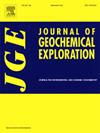华北克拉通山东省西部带状铁质地层的沉积时代和来源物质:地球化学、锆石UPb地质年代和SmNd同位素组成的制约因素
IF 3.4
2区 地球科学
Q1 GEOCHEMISTRY & GEOPHYSICS
引用次数: 0
摘要
鲁西地区是华北克拉通重要的铁矿集中区,是研究带状铁形成演化的理想地区。本文对东阿山庄(SZ)、沂源汉旺(HW)、沂水阳庄(YZ)、临沂兰岭(LL)和济宁盐店(YD)不同BIF含矿单元和深度的BIF矿床进行了对比研究。锆石UPb测年结果表明,WSP BIF的沉积年龄限制在新太古代晚期(2.56 ~ 2.50 Ga),与北陆盆地大部分BIF的沉积年龄(2.55 ~ 2.52 Ga)一致。大多数裂口经历了绿片岩-角闪岩相变质和伴生岩浆作用,开始于~ 2.49 Ga。其特征为轻稀土元素(lree)的贫化和Y、Ce的正、负异常,表明其是由海水和少量高t热液混合形成的。其他额外的稀土和钇(REY)来源,如河流输入和(或)海洋地壳衍生的通量,可能也参与了bif形成过程。大部分表壳上岩石和变花岗岩呈右倾REY型,与洋岛玄武岩(OIB) REY型相似;角闪岩REY型呈平向,与正常洋中脊玄武岩(N-MORB) REY型相似。新太古代晚期的表壳岩原岩反映了从科马铁矿-拉斑岩到钙碱性玄武岩-安山岩-英安岩的演化过程,可能形成于火山弧环境。YZ BIF是WSP中最接近海水的最纯净的化学沉积物,可以作为追踪古代海水的有利档案。bif及伴生岩的变初始εNd(t)值为+0.85 ~ +6.96,主要介于贫化地幔与球粒质均匀储层之间,说明海水主要受贫化地幔物质的影响,但不能排除大陆地壳的贡献。WSP bif不同岩石的Nd模式年龄在2.80 ~ 2.58 Ga之间,对应于NCC大尺度大陆地壳生长年龄。SmNd同位素拟等时线的表观等时线年龄为2685±89 Ma,为“古等时线”,可能对应于古~ 2.70 Ga大陆地壳生长事件的年龄。本文章由计算机程序翻译,如有差异,请以英文原文为准。
Depositional age and source material of banded iron formations in the Western Shandong Province, North China Craton: Constraints from geochemistry, zircon UPb geochronology and SmNd isotope composition
As an important iron ore concentration area in the North China Craton (NCC), the Western Shandong Province (WSP) is an ideal area to study the formation and evolution of banded iron formation (BIF). This paper performs a comparative study on the BIF deposits of Dong'e Shanzhuang (SZ), Yiyuan Hanwang (HW), Yishui Yangzhuang (YZ), Linyi Lanling (LL), and Jining Yandian (YD), from different BIF-hosted units and depths. Zircon U![]() Pb dating revealed that the depositional age of the WSP BIFs here was constrained to the Late Neoarchean (2.56–2.50 Ga), consistent with most of the BIF depositional age (2.55–2.52 Ga) in the NCC. The majority of BIFs have undergone greenschist- to amphibolite-facies metamorphism and associated magmatism that began at ∼2.49 Ga. The BIFs are characterized by depleted light rare earth elements (LREEs) and positive Y and negative Ce anomalies, indicating that BIFs precipitated from a variable mixing of seawater and minor high-T hydrothermal fluids. The other additional rare earth and yttrium (REY) sources such as fluvial inputs and (or) oceanic crust-derived fluxes are probably involved during the formation of BIFs. However, most supracrustal rocks and metagranitoids show a right-tilting trend in REY pattern, which is similar to that of the ocean island basalts (OIB) pattern, while the REY pattern of amphibolite is flat, similar to that of normal mid-ocean ridge basalts (N-MORB) pattern. The protoliths of supracrustal rocks in the Late Neoarchean reflect an evolution process from komatiite-tholeiite to calc-alkaline basalt-andesite-dacite, and BIFs were possibly formed in a volcanic-arc setting. The YZ BIF is the purest chemical sediment closest to seawater in the WSP, which can be used as a favourable archive for tracing ancient seawater. The variable initial εNd(t) values of the BIFs and associated rocks were determined as +0.85 − +6.96, mostly between the depleted mantle and the chondritic uniform reservoir, indicating the seawater was largely affected by the depleted mantle material, but cannot excluded the contributions from continental crust. The Nd model age of different rocks of WSP BIFs was 2.80–2.58 Ga, corresponding to a large-scale continental crustal growth age of the NCC. The apparent isochron age fitted to the Sm
Pb dating revealed that the depositional age of the WSP BIFs here was constrained to the Late Neoarchean (2.56–2.50 Ga), consistent with most of the BIF depositional age (2.55–2.52 Ga) in the NCC. The majority of BIFs have undergone greenschist- to amphibolite-facies metamorphism and associated magmatism that began at ∼2.49 Ga. The BIFs are characterized by depleted light rare earth elements (LREEs) and positive Y and negative Ce anomalies, indicating that BIFs precipitated from a variable mixing of seawater and minor high-T hydrothermal fluids. The other additional rare earth and yttrium (REY) sources such as fluvial inputs and (or) oceanic crust-derived fluxes are probably involved during the formation of BIFs. However, most supracrustal rocks and metagranitoids show a right-tilting trend in REY pattern, which is similar to that of the ocean island basalts (OIB) pattern, while the REY pattern of amphibolite is flat, similar to that of normal mid-ocean ridge basalts (N-MORB) pattern. The protoliths of supracrustal rocks in the Late Neoarchean reflect an evolution process from komatiite-tholeiite to calc-alkaline basalt-andesite-dacite, and BIFs were possibly formed in a volcanic-arc setting. The YZ BIF is the purest chemical sediment closest to seawater in the WSP, which can be used as a favourable archive for tracing ancient seawater. The variable initial εNd(t) values of the BIFs and associated rocks were determined as +0.85 − +6.96, mostly between the depleted mantle and the chondritic uniform reservoir, indicating the seawater was largely affected by the depleted mantle material, but cannot excluded the contributions from continental crust. The Nd model age of different rocks of WSP BIFs was 2.80–2.58 Ga, corresponding to a large-scale continental crustal growth age of the NCC. The apparent isochron age fitted to the Sm![]() Nd isotope pseudo-isochron of 2685 ± 89 Ma represents a “paleo-isochron”, possibly corresponding to the age of the older ∼2.70 Ga continental crust growth event.
Nd isotope pseudo-isochron of 2685 ± 89 Ma represents a “paleo-isochron”, possibly corresponding to the age of the older ∼2.70 Ga continental crust growth event.
求助全文
通过发布文献求助,成功后即可免费获取论文全文。
去求助
来源期刊

Journal of Geochemical Exploration
地学-地球化学与地球物理
CiteScore
7.40
自引率
7.70%
发文量
148
审稿时长
8.1 months
期刊介绍:
Journal of Geochemical Exploration is mostly dedicated to publication of original studies in exploration and environmental geochemistry and related topics.
Contributions considered of prevalent interest for the journal include researches based on the application of innovative methods to:
define the genesis and the evolution of mineral deposits including transfer of elements in large-scale mineralized areas.
analyze complex systems at the boundaries between bio-geochemistry, metal transport and mineral accumulation.
evaluate effects of historical mining activities on the surface environment.
trace pollutant sources and define their fate and transport models in the near-surface and surface environments involving solid, fluid and aerial matrices.
assess and quantify natural and technogenic radioactivity in the environment.
determine geochemical anomalies and set baseline reference values using compositional data analysis, multivariate statistics and geo-spatial analysis.
assess the impacts of anthropogenic contamination on ecosystems and human health at local and regional scale to prioritize and classify risks through deterministic and stochastic approaches.
Papers dedicated to the presentation of newly developed methods in analytical geochemistry to be applied in the field or in laboratory are also within the topics of interest for the journal.
 求助内容:
求助内容: 应助结果提醒方式:
应助结果提醒方式:


